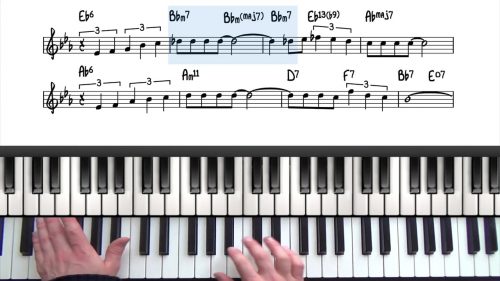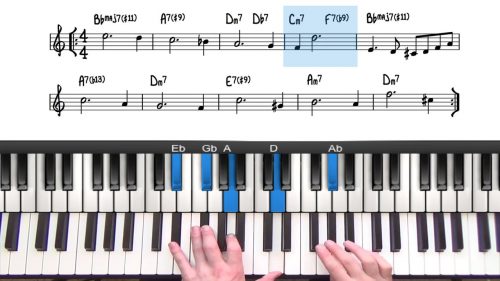Upper Structures for Major & Minor Chords
In the past lessons on upper structures, we have explored them over dominant chords. In this lesson we apply the upper structure triad concept to major and minor chords.
Print Out The Upper Structure Cheat Sheet
You can find a link below to the Upper Structure Cheat Sheets which detail the type of chord, the scale degree to build the triad off, and finally the extensions and alterations included.
Upper Structures Over Dominant Chords
In the past lessons on upper structures, we just looked at dominant upper structures. For example, over C7 we can play a major triad built from the #5 to get an altered #5-#9 sound. Or we can play a major triad off the #11 to get a #11 – b9 sound. We also looked at adding these upper structures to a 251 progression.
Previous Lessons On USTs
If you don’t understand this theory, I would recommend watching the introduction to upper structures lesson. Applying upper structures to dominant chords is the most important and useful application so I would advise that you learn dominant upper structures first.
Lesson Downloads
-
Major and Minor Upper Structures Cheat Sheet File Type: pdf
Practice Tips
-
Print off the major/minor upper structure cheat sheet.
-
By visualising the chord in two separate parts, it gives us access to a winder variety of voicings for the same chord.
-
We can manipulate a simple voicing by inverting and doubling notes of the upper structure.
-
Try harmonising a melody line of a jazz standard using major and minor upper structures. First analyse the notes in the meldoy, and then try and match them to the chord tones in the upper structure of the chord.
-
We can invert a single upper structure and also mix multiple upper structures to get the correct tone at the top of the voicings.








Wow – Even though I knew and had used a few shortcuts for extended chords I had never thought of actually treating them as separate triads with the ability to achieve such big sounds by inverting the upper triads. Really enjoying trying this out, thanks Hayden!
Glad you enjoyed in James!
Yes you can get some really big sounds, and also more flexibility with voicings by looking at the chord as 2 separate structures… some of the formulas are the same too, for example, major triad off the 9th will give you 13#11 sound over both major and dominant chords… so there is some overlap with dominant uppers structure theory.
Cheers,
Hayden
Hi Hayden. Can you send me the lead sheed for this lesson. The chead sheet I have. It would be cool if you had the lead sheed for this.
HI Jimmy,
Apologies for the late reply, this comment slipped past me.
Yes we actually have a tutorial on that tune where you can access all of the notation from the lesson.
Here’s a link: pianogroove.com/jazz-piano-lessons/time-remembered-tutorial/
Cheers!
Hayden
This is really helpful – thanks, Hayden!
Makes memorizing / finding great voicings to fit certain melodies much easier w this shortcut/conceptualization. I’ve been looking for something like this.
Question: can something like this be applied to most voicings in general (I’m thinking of the lesson on arranging for solo piano, which I’ve started). Or do some voicings just require you memorize them, which is best done applying them directly to jazz standards?
Thanks!
Clif
Hi Cliff,
Great question.
Yes you are correct that this concept can be applied to many different types of voicings.
One of the main benefits is that we can then see our hands are 2 separate parts of the chord and we can move and manipulate each hand independently by inverting the chord structure which allows us to access lots of different “textures” for the same chord colour.
You might like to check out this 5 minute masterclass on “Upper Structure Triads” where I discuss this in more detail:
pianogroove.com/jazz-piano-lessons/what-are-upper-structure-triads/
Let me know if I can help further with this.
Cheers,
Hayden
Hi Hyden,
very interesting course about Upper Structures.
I would have a question…
A sort of ”Upper Structures” for sus/semi diminished/diminished chords… Do they exist?
If so, it would be nice to get a piece of advice about this topic from you or understand if you are planning to to crate a course about that.
Thanks so much for your time.
Cheers,
Emanuele
Hi Emanuele,
Great question.
Yes we can view many voicing types as ‘upper’ and ‘lower’ structures and in fact, this can be very useful to find different voicing combinations for the same chord colour.
For sus chords, there are a number of different formulas:
1) Root in left hand and major triad off the b7, this gives you a Sus9 sound
2) Root in left hand and major 7th chord off the b7, this gives you a Sus13 sound
3) Root and b7 in the left hand, and a minor 7th chord off the 9th gives a Sus13 sound with the root in the melody – this voicing works great when we have the root in the melody over a dominant chord
For more information on Sus voicings check out the following 2 lessons:
pianogroove.com/live-seminars/how-to-play-like-beegie-adair/ (starts with a recap of sus chord theory and the useful formulas above)
pianogroove.com/jazz-piano-lessons/how-to-play-sus-chords/
For -7b5 chords, there is an interesting relationship which connects 2 dominant upper structures and a -11b5 chord.
If we take the notes D and Ab in our left hand, and then a C major triad in our right hand, this can function as all 3 of the following voicings:
– Rootless Bb(13#11)
– Rootless E7(#5#9)
– D-11b5
Check out the following lesson on this:
pianogroove.com/jazz-piano-lessons/2-handed-minor-251/
That lesson covers the minor 7b5 voicing which is in itself an upper structure, and it can also function as 2 different rootless dominant upper structure triads.
It’s also important to understand the tritone relationship here, so for example C13(#11) could be seen as:
D Major Triad over C7
If we change just the root note from C to F# (C and F# are tritone subs) we then have F#7(#5#9). So just by changing the root note we get a completely different flavour to the chord.
Finally for diminished chords, UST theory does not apply in the same way due to the “symmetry” in diminished voicings, however, you might like to learn about the “diminished shadow” also known as “double diminished”, check out chapter 4 of this lesson:
pianogroove.com/bossa-nova-lessons/useful-diminished-trick-for-any-251/
I hope that helps Emanuele. Take a look over the lessons above and let me know if you have any further questions.
Cheers,
Hayden